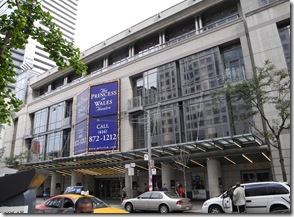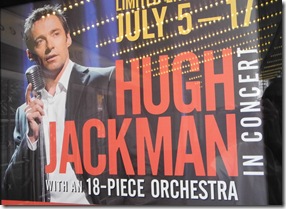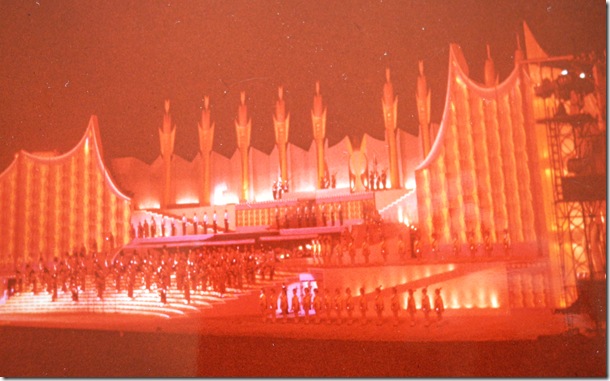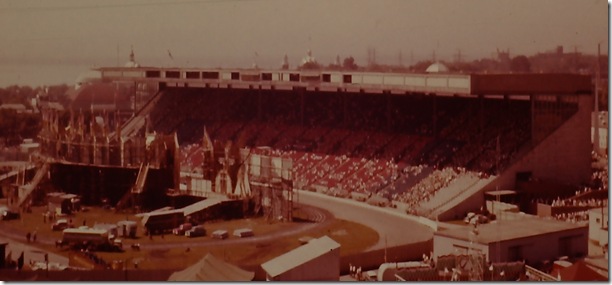Though my interests centre around the history and architecture of Toronto, I decided to include a post on Hugh Jackman after attending the opening night performance of his one-man show at the Princess of Wales Theatre. It has been a long time since I felt that I was viewing theatrical history. Every era has its “greats” – people whose skills and stage presence transcend them into “legends of the theatre.” Sarah Bernhardt, Edith Piaf, Al Jolson and Frank Sinatra are a few that come to mind. We can now add Hugh Jackman to the list of “greats.”
His show is part rock concert, Broadway musical, and Las Vegas glitz. With its creative staging, his superb musical talent, and the ever-changing lighting, it hearkens back to the days of the CNE Grandstand shows of yesteryears.
A CNE Grandstand Show of the mid-1950s.
The CNE Grandstand in the 1950s, with the stage and scenery in place for an evening performance.
The CNE Grandstand Shows were large-scale performances of music and dance, choreographed by Celia Franca, the founder of the Toronto’s National Ballet of Canada. The similarity between these spectacles and the Hugh Jackman show in Toronto may seem obscure. However, they both centre around a single performer, whose skills are able to capture the audience for an entire evening. The orchestra, the lighting, and the staging augment the performances, but everyone knows that it is the talent of “the star” that carries the show from beginning to end.
Jackman was on stage at the Princess of Wales Theatre for slightly over two hours, including a much-welcomed encore. Similar to the days of the big-band era, the eighteen-piece band was in full view, the lighting on the musicians changing according to the prominence of their role. At times, a semi-transparent curtain descended to obscure the band, and at other moments the musicians were in full view, highlighted with various colours.
Jackman opened the show with a song from “Oklahoma,” and from that moment onward, he played the audience with charm and skill, at times a trifle raunchy. He teased, flirted, shook his buns, and shimmied his body provocatively as he performed a mock-striptease and athletically kicked the can-can. This is the man who played “Wolverine?” He pulled the audience along in his wake as his dancing sailed across the stage, sometimes moving so smoothly that appeared to have no skeleton. He included tap-dancing, rumba, and waltzing, while he sang Broadway hits, Oscar winning melodies, love songs, and even a rap number. Once he perched on a bar-stool to sing, and on another occasion he reclined in a casual pose on the stairs at the edge of the stage. Even the song he performed with one hand in his pocket, and the other holding a microphone, he held the attention of his listeners.
Visuals projected on a large screen augmented the songs. Photos of his various movie roles added insight into the range of the man’s talent. In one section, the orchestra played the opening theme-music employed by 20th-Century Fox Studios, and on the screen appeared the titles for “American In Paris,” as Jackman recreated the “dance-with-the-umbrella song” immortalized by Gene Kelly – “Singing In The Rain.” The songs that honoured his native Australia and its aboriginal people, as well as the tribute to Judy Garland, were haunting. The song from “Carousel,” “My Boy Bill,” was classic.
The show premiered in San Francisco, but Toronto was chosen as the first city after its initial trial run. It is a natural for Broadway, but due to the demands of his contracts, he may never have the time to take it there. It is an evening of great theatre. See it if you can!



